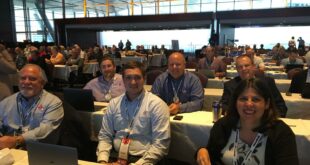As this issue of Sprinkler Age will be available at the NFPA Annual Conference & Expo®, this column will serve a special purpose. In preparation for the 2022 NFPA Technical Meeting, AFSA has reviewed the posted Certified Amending Motions (CAMs) for the relevant standards on the A2022 and F2021 revision cycles and is providing a voting guide as a special issue of Higher Standards. These CAMs are related to NFPA 25, Standard for the Inspection, Testing, and Maintenance of Water-Based Fire Protection Systems.
CAM 25-2 – External Loads and Material Compatibility
Accept Committee Comment No. 3
AFSA Position: OPPOSE
This CAM intends to add a requirement to inspect materials in contact with nonmetallic sprinkler pipe to verify that there are no incompatible materials. This task is an ongoing responsibility of the owner based on the language added to Chapter 4 by SR-4, and it is not necessary to restate the language in Chapter 5. While the requirements of NFPA 25 are ultimately the responsibility of the owner, contractual relationships may shift the responsibility to an inspecting contractor to perform some or all the tasks required by specific chapters. It is not practical to require an inspector to verify the ever-changing compatibility list of CPVC pipe.
CAM 25-3 – Nonsystem Components
Accept an Identifiable Part of Committee Comment No. 3
AFSA Position: SUPPORT
While CAM 25-2 moves to accept CC-3 in its entirety, CAM 25-3 only looks to accept the committee’s revision to section 5.2.2.2 which failed ballot. This change requires pipe to be inspected annually from the floor to verify that the pipe is not supporting nonsystem components. This language correlates with NFPA 13 requirements and provides an easily identifiable action that an inspector can report on.
CAM 25-10 – Nonmetallic Sprinkler Piping
Reject Second Revision No. 4
AFSA Position: OPPOSE
This CAM proposes the deletion of the CPVC compatibility requirements from Chapter 4. The owner of a building is ultimately responsible for that structure and the materials that are put in it. The only practical and reasonable approach is to make the owner responsible for the ongoing compatibility of materials in contact with CPVC piping.
CAM 25-15 – Water Mist Positive Displacement Pumping Units
Reject Second Revision No. 60
AFSA Position: OPPOSE
The submitter of CAM 25-15 argues that the additional flow testing requirements for water mist positive displacement pumping units are excessive due to the requirement of an annual flow test and an annual activation test. While the submitter stated in their negative vote on SR-60 that water mist fire pumps should be treated no differently than traditional fire pumps, it should be noted that a water mist system is NOT a sprinkler system. SR-60 was developed by a joint task group from NFPA 20 and NFPA 750 and AFSA supports that group’s work. This CAM should be rejected.
CAM 25-16 – Concealed Sprinklers
Reject Second Revision No. 2
AFSA Position: OPPOSE
The new requirement to remove the cover plates of concealed sprinklers and inspect on a five-year basis is the sprinkler industry’s version of a tree falling in the forest with no one there to hear it. The lack of data referenced in many negative votes is simply due to the fact that we have not gathered the data, and the only way to gather data is to pull cover plates and verify the functionality of the concealed sprinkler. A five-year frequency for this inspection is reasonable and adds no greater burden on the inspector as the time interval aligns with other five-year activities that would require additional equipment to reach the ceiling level. Additionally, the sample size correlates with the testing requirements for sprinklers—the greater of four sprinklers or
1 percent. This CAM should be rejected.
CAM 25-17 – Clearance to Storage
Reject an Identifiable Part of Second Revision No. 13
AFSA Position: OPPOSE
This CAM looks to remove the reference to the annual inspection of sprinklers to verify proper clearance to storage is provided from Table 5.1.1.2. Whether or not this line item is removed, the requirements of section 5.2.1.2 remain, and this inspection would still be required. For consistency, the table should remain unchanged, and this CAM should be rejected.
CAM 25-18 – Net Fire Pump Performance
Reject Second Revision No. 61
AFSA Position: OPPOSE
When interpreting flow test results for fire pumps, the net performance of the fire pump is a quantitative determination of the fire pump’s performance. If the data from the manufacturer’s curve can be achieved, there is nothing deficient about the fire pump assembly. When interpreting the gross performance of the fire pump, that will determine if there is an adequate water supply to feed any water-based systems downstream. A diminished gross performance should not make a fire pump assembly categorically deficient when the net performance is satisfactory. This CAM should be rejected.
 ABOUT THE AUTHOR: Kevin Hall is the coordinator of engineering and technical services for the American Fire Sprinkler Association (AFSA). He is a member of, and involved in, several National Fire Protection Association (NFPA) technical committees responsible for developing the model codes and standards including, NFPA 1 Fire Code, NFPA 13/13R/13D Installation of Sprinkler Systems, NFPA 20 Installation of Stationary Fire Pumps for Fire Protection, NFPA 30 Flammable and Combustible Liquids Code, and NFPA 915 Remote Inspections. He also represents AFSA on numerous UL standard technical panels responsible for revising and maintaining the product standards used in the sprinkler industry. Hall is a registered professional engineer in Delaware and Maryland, NICET III-certified in water-based system layout, a Certified Water-Based System Professional (NFPA), and a professional member of the Society of Fire Protection Engineers. He earned his Bachelor of Science and Master of Engineering degrees from the University of Maryland, College Park, in fire protection engineering. Prior to his association and committee work, Hall worked for Reliance Fire Protection in Baltimore, Maryland as a project manager overseeing projects of various sizes and complexity for the Contracts Division.
ABOUT THE AUTHOR: Kevin Hall is the coordinator of engineering and technical services for the American Fire Sprinkler Association (AFSA). He is a member of, and involved in, several National Fire Protection Association (NFPA) technical committees responsible for developing the model codes and standards including, NFPA 1 Fire Code, NFPA 13/13R/13D Installation of Sprinkler Systems, NFPA 20 Installation of Stationary Fire Pumps for Fire Protection, NFPA 30 Flammable and Combustible Liquids Code, and NFPA 915 Remote Inspections. He also represents AFSA on numerous UL standard technical panels responsible for revising and maintaining the product standards used in the sprinkler industry. Hall is a registered professional engineer in Delaware and Maryland, NICET III-certified in water-based system layout, a Certified Water-Based System Professional (NFPA), and a professional member of the Society of Fire Protection Engineers. He earned his Bachelor of Science and Master of Engineering degrees from the University of Maryland, College Park, in fire protection engineering. Prior to his association and committee work, Hall worked for Reliance Fire Protection in Baltimore, Maryland as a project manager overseeing projects of various sizes and complexity for the Contracts Division.
 Sprinkler Age A Publication of the American Fire Sprinkler Association
Sprinkler Age A Publication of the American Fire Sprinkler Association

